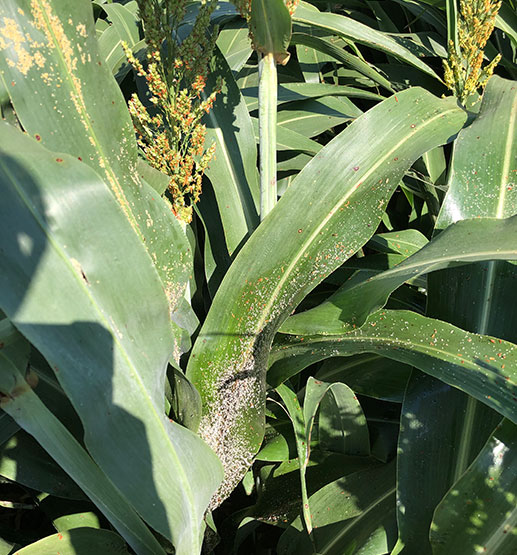
Hot, humid conditions in Kansas have been conducive to sorghum aphid developing in parts of the state, said K-State crop entomologist Jeff Whitworth. Producers are urged to monitor sorghum fields for the presence of small colonies.
Q&A: K-State entomologist shares insights on sorghum aphids
Aug. 8, 2022
By Pat Melgares, K-State Research and Extension news service
MANHATTAN, Kan. – Though infestations have been minimal, Kansas extension professionals have reported separate incidents of sugarcane aphids in early August.
Near Ellsworth, Kan., Midway Extension District agricultural agent Craig Dinkel reported a single case of the sugarcane aphid (now also called the sorghum aphid) in a farmer’s sorghum crop. Additional cases have been reported in Pottawatomie and Sedgwick counties.
Kansas State University crop entomologist Jeff Whitworth answered questions to help producers and others understand these microscopic insects better.
Have the weather conditions in Kansas been right for sugarcane aphids?
Whitworth: Sugarcane aphids are considered sub-tropical or tropical aphids, so they develop well in warmer, more humid conditions. We have had warm and hot temperatures with a little more humidity lately, so yes, I think our weather has been conducive to sugarcane aphid development around Kansas.
Our winter weather has been too cold for these aphids to successfully overwinter. That is one of the reasons we have seen these aphids migrate into the state on south winds, starting anywhere from mid-July, and still in early October.
From what you know at this point, is the Ellsworth County incident isolated, or maybe representative of what's going on in the state?
Whitworth: I'm sure the reports of sugarcane aphids from Ellsworth County are just the first of many more to come. Every year since 2014 we have seen these aphids migrate into the state, generally being reported from south to north, and I would expect the same this year.
Since about 2018, however, they have not been as large or widespread a problem as they were in 2015-2017. These aphid colonies are started by a winged female that is blown in on a southern wind, lands on a sorghum leaf and is not immediately eaten or paralyzed by a beneficial insect. So she starts producing female nymphs that mature within a few days, and those produce more female nymphs until you have large colonies.
However, every year since 2018, I have flagged off small colonies in early August in several places and several fields around the state only to have those colonies be decimated by beneficial insects. That is why you do not want to be too quick to make an insecticide application.
What can farmers do if they discover an infestation?
Whitworth: Right now growers and crop consultants need to be monitoring all sorghum fields for the presence of small colonies of sugarcane aphids (and if the sorghum is between flowering and soft dough stages, monitor for headworms) and beneficials, as they have seemed to really help control these aphids in past years.
For management options (such as sampling,treatment thresholds, registered insecticides (and more) please refer to the 2022 KSU Sorghum Insect Management guide. There are some really good products available that target aphids almost exclusively.
So, good advice at this point is to be mindful, right?
Whitworth: It is very early in the infestation, and I would like to congratulate the folks in Ellsworth and Pottawatomie counties that have been rigorously sampling sorghum well enough to find these early colonies. It is no fun to carefully sample crop fields in this weather and especially when there are no pests to find -- which is what we hope for -- but it is always more interesting when you find something. You just don't want it to get out of control.

